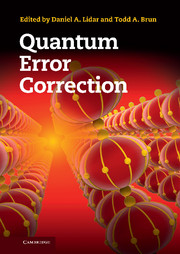Book contents
- Frontmatter
- Contents
- List of contributors
- Prologue
- Preface and guide to the reader
- Acknowledgements
- Part I Background
- 1 Introduction to decoherence and noise in open quantum systems
- 2 Introduction to quantum error correction
- 3 Introduction to decoherence-free subspaces and noiseless subsystems
- 4 Introduction to quantum dynamical decoupling
- 5 Introduction to quantum fault tolerance
- Part II Generalized approaches to quantum error correction
- Part III Advanced quantum codes
- Part IV Advanced dynamical decoupling
- Part V Alternative quantum computation approaches
- Part VI Topological methods
- Part VII Applications and implementations
- Part VIII Critical evaluation of fault tolerance
- References
- Index
3 - Introduction to decoherence-free subspaces and noiseless subsystems
from Part I - Background
Published online by Cambridge University Press: 05 September 2013
- Frontmatter
- Contents
- List of contributors
- Prologue
- Preface and guide to the reader
- Acknowledgements
- Part I Background
- 1 Introduction to decoherence and noise in open quantum systems
- 2 Introduction to quantum error correction
- 3 Introduction to decoherence-free subspaces and noiseless subsystems
- 4 Introduction to quantum dynamical decoupling
- 5 Introduction to quantum fault tolerance
- Part II Generalized approaches to quantum error correction
- Part III Advanced quantum codes
- Part IV Advanced dynamical decoupling
- Part V Alternative quantum computation approaches
- Part VI Topological methods
- Part VII Applications and implementations
- Part VIII Critical evaluation of fault tolerance
- References
- Index
Summary
Introduction
In the previous chapter we saw how quantum information can be protected by active means. A combination of encoding and syndrome measurements, followed by corrective operations conditioned on the syndrome measurement outcomes, led to a method by which quantum information could be error corrected. In this chapter we will see how quantum information can be protected passively. Rather than attempting to fix errors, we will hide the quantum information from the environment, so that it never becomes corrupted. This “quiet corner” of the system's Hilbert space is called a decoherence-free subspace (DFS) or noiseless subsystem (NS). The main mechanism that will allow us to play this trick is symmetry. Every student of physics knows that symmetries lead to conservation laws. In our case the conserved quantity will turn out to be quantum information. Of course such symmetries must be exceedingly rare, or else protected quantum information would be all around us. Thus we will be forced to make some very strong assumptions, and ask the environment to “cooperate.” While we will definitely allow the environment to couple to our system, we will only allow it to do so in a certain symmetric manner. We will later discuss how relaxing this “cooperation requirement” still allows quantum information to be passively protected for a short time. In Chapter 4 we will see how, by using dynamical decoupling techniques, it becomes possible to force the environment to cooperate, i.e., to dynamically generate symmetries leading to a DFS or NS.
- Type
- Chapter
- Information
- Quantum Error Correction , pp. 78 - 104Publisher: Cambridge University PressPrint publication year: 2013
- 2
- Cited by



